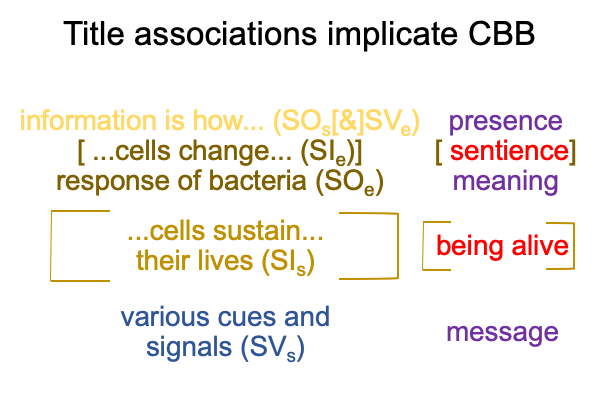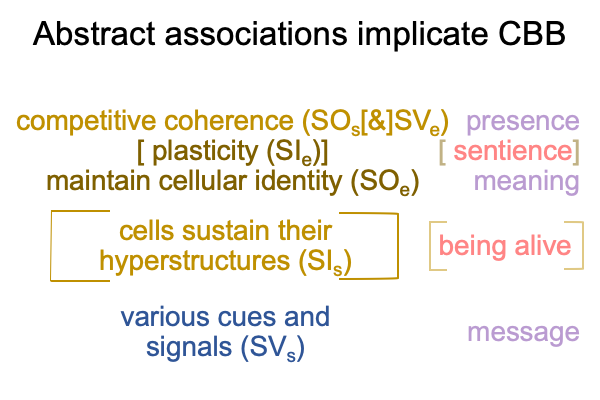0648 The text before me is chapter fourteen in Pathways (see point 0474 for book details). The chapter covers pages 299 to 324. The authors are Vic Norris at the University of Rouen, France, and Alexei Sharov at Elixirgen Scientific in Baltimore, Maryland.
The full title is “Hypothesis about How Bacterial Cells Sustain and Change Their Lives in Response to Various Signals”. The fullness of the title is significant. Elements may be associated to the S&T noumenal overlay.
0650 Here are my associations.

The only term not in the association is “hypothesis”.
0651 Looking back to chapter 13, concerning the sentient cell, the model of the Cellular Basis of Consciousness (CBB), illuminates what the authors are constructing. They project sentience from human consciousness onto the behavior of living bacteria. Life and sentience are coterminous.
I suppose the authors’ hypothesis proposes that such a project is scientifically legitimate.
I already know the answer from the S&T noumenal overlay. Semiotic agency2 is a reification of a three-level interscope, a purely relational structure which contains the specifying and exemplar sign relations. This allows the designation of features that are crucial for empirio-schematic inquiry: phenomena and what needs to be modeled.
0652 Message, presence and meaning associate to phenomena.
The contiguities of [life] and [sentience] are what need to be modeled.
0653 Unfortunately, the authors do not have tools to visualize Peirce’s philosophy, which opens a window to two realms that cannot be observed and measured by humans: normal context3 and potential1. Indeed, these two realms constitute the sign-interpretants of level-crossing sign-relations. Which explains why [life] and [sentience] are precisely what models need to explain.
0654 So, how to the authors proceed?
The abstract and the first two sections (14.1 and 14.2) inform the reader as to the character of the project.
The proposed model for [self-governance3b operating on potential courses of action1b (SIs)] describes bacteria as hierarchically structured. Functional roles are performed by hyperstructures, assemblies of molecules and macromolecules operating in multiple-level coordination as subagents. “Hyperstructures” are functionally competent states (coordinating as “temporal phenotypes”).
This model envisions subagents scrambling to support the ongoing hyperstructure or to change to a more appropriate hyperstructure. The authors label this scramble, “competitive coherence”.
The proposed model for [salience3c((1c)) (SIe)] is “plasticity”. The resulting coordinated order among subagentsmaintains or changes cellular integrity… er… “identity”, as conditions either remain the same or alter. Plasticity addresses the question, “What is the bacteria going to do?” In effect, competitive coherence establishes a stage for a phenotypic expression of the holobiont.
0655 Does this argument flow into the structure of the S&T noumenal overlay?
Here are my associations.

0656 For the specifying sign-relation, various cues and signals2a (SVs) stand for competitive coherence2b (SOs) in regards to bacteria cells responding3b by potentially sustaining or changing their hyperstructure (or “temporal phenotype”)1b (SIs).
For the exemplar sign-relation, competitive coherence2b (SVe) stands for maintaining the cell’s identity2c (SOe) through plasticity3c((1c)) (SIe), where plasticity is the ability to hold or shift from one temporal phenotype to another.
0657 Now, an expert in bacteria should be able to observe and (in experiments) measure phenomena related to cues and signals2a (which the researcher can control), competitive coherence2b (patterns of behavior among bacterial subagents) and the maintenance or change of cell identity2c (observed as what actions the holobiont takes).
0658 These noumena may be objectified as phenomena that the researcher observes and measures.
